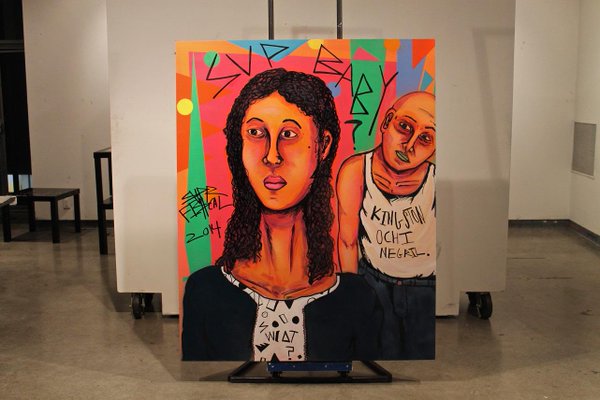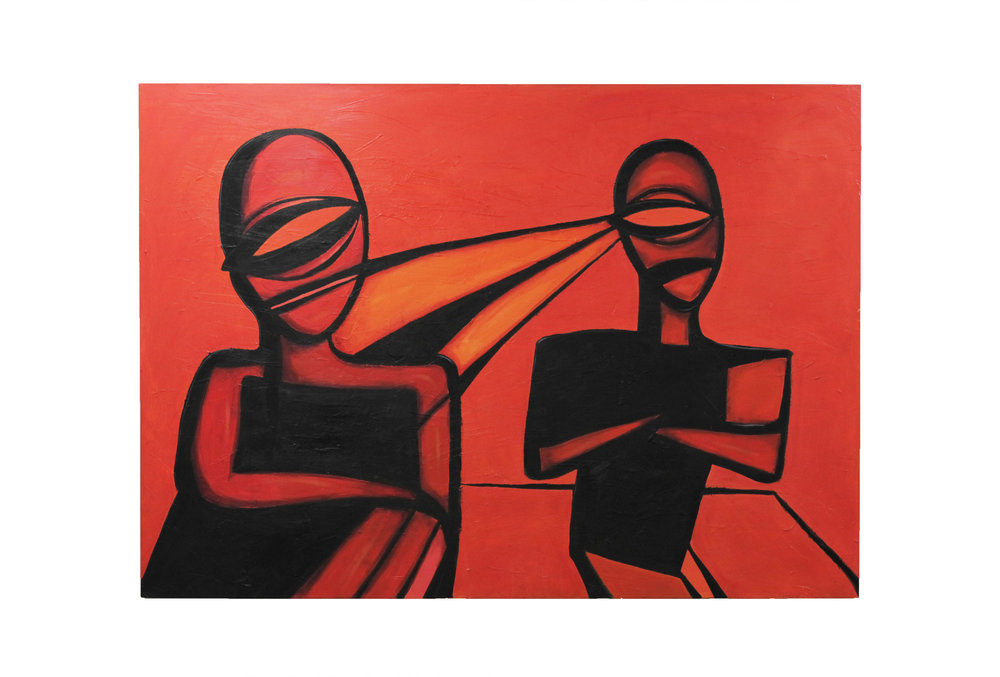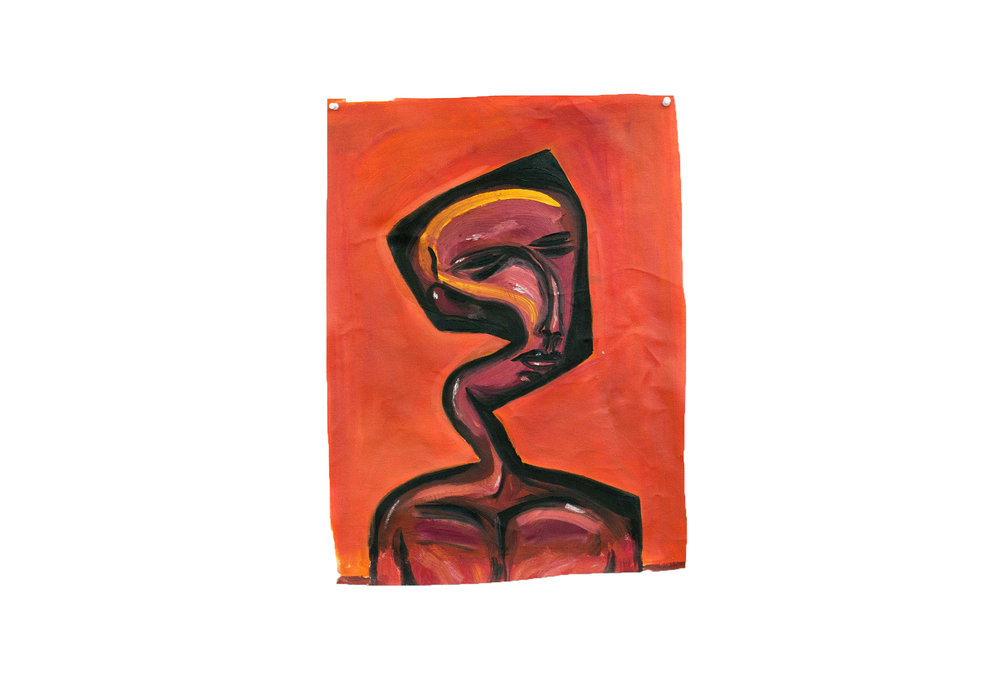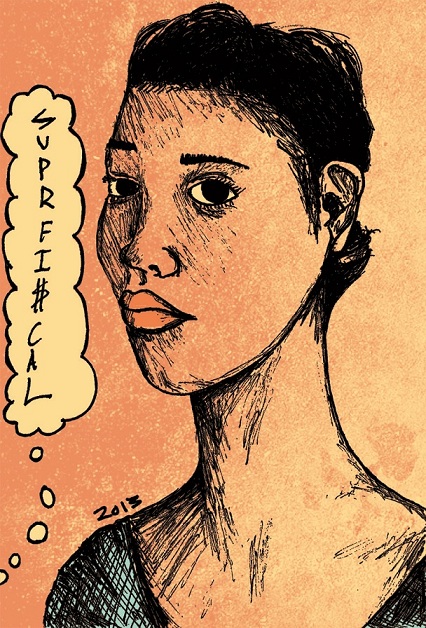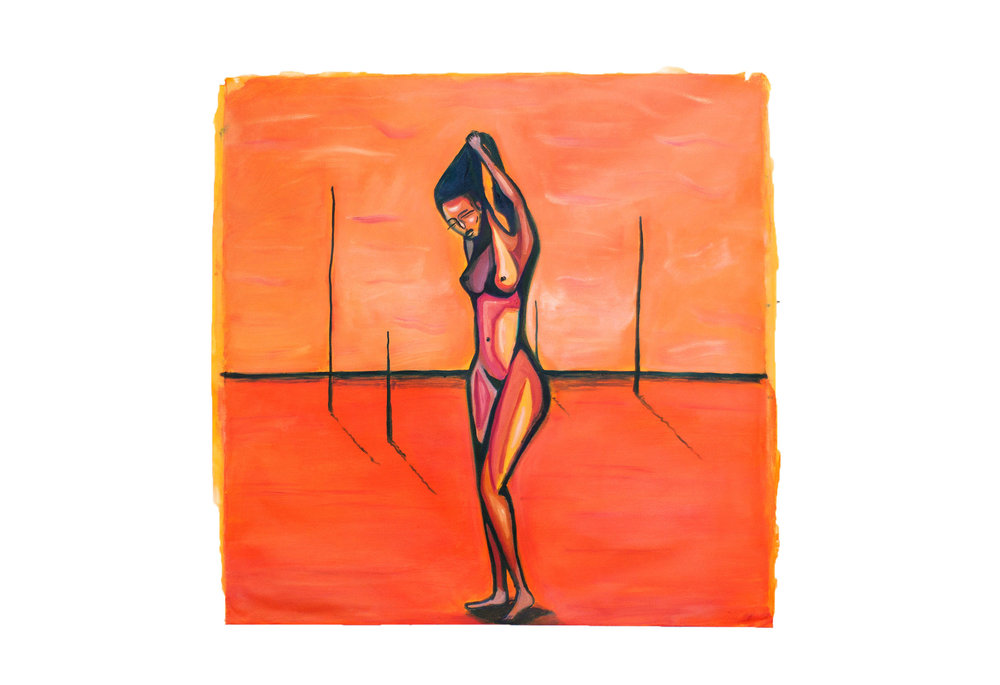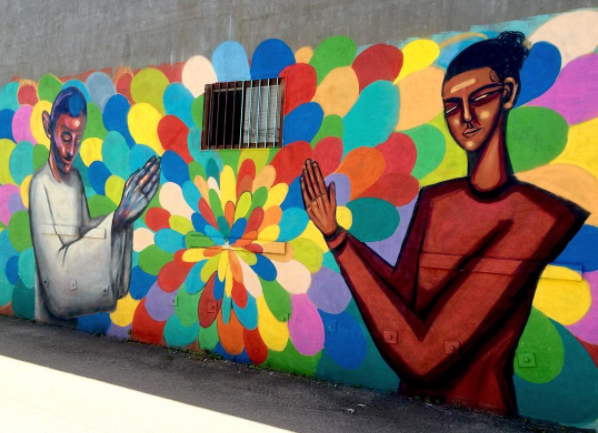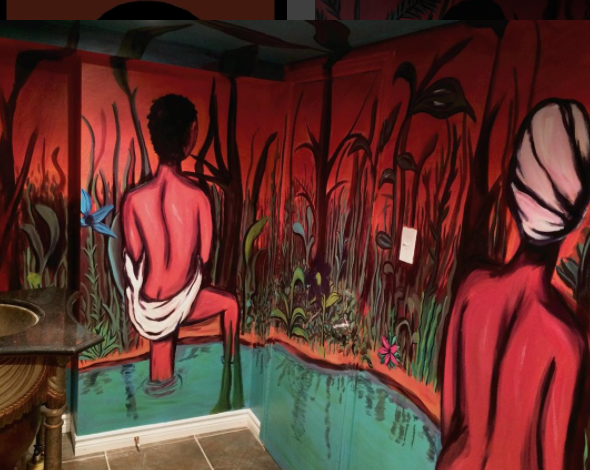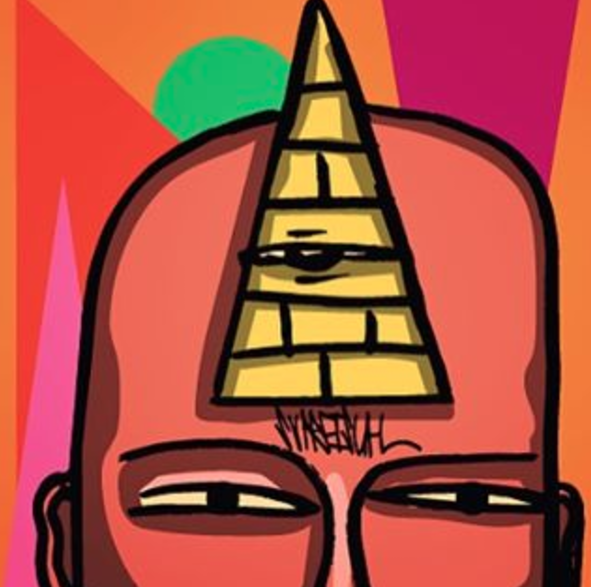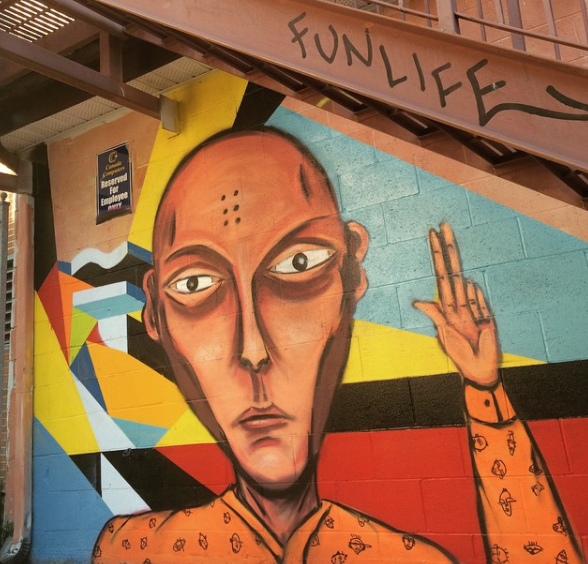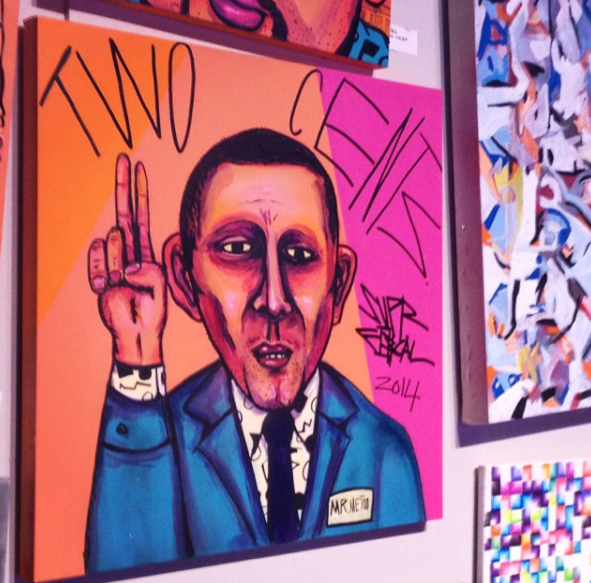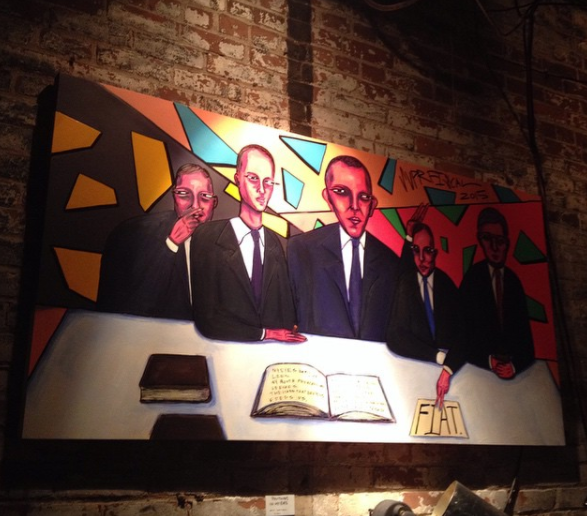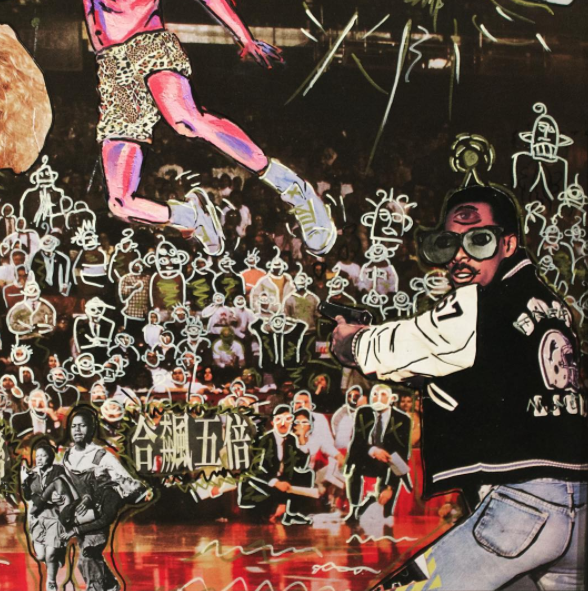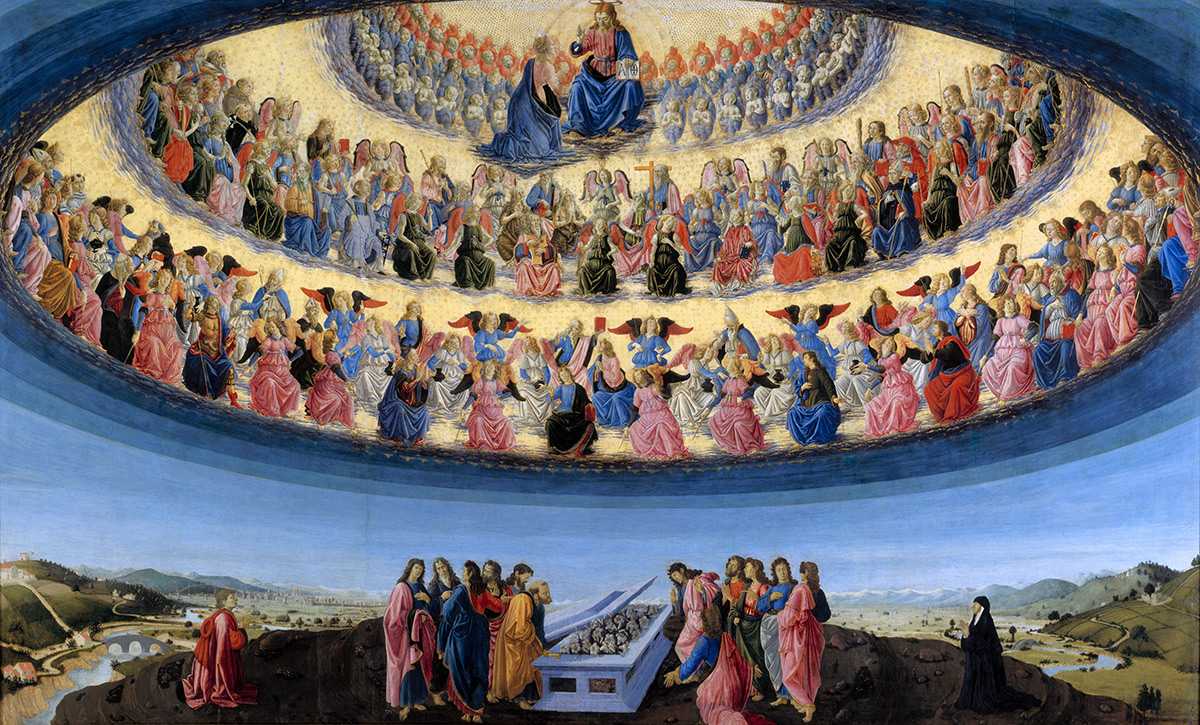
This is a transcription of an audio lecture:
I was talking with a man a couple of days ago who said, “Meditation is the hardest thing you can do.” This is a perspective shared by a lot of people. Yet, it is not exactly accurate.
Real Meditation is a state of Consciousness. In fact, the state of Meditation is the natural state of the Consciousness, when it is unconditioned. The state of Meditation is not separate from our true identity. When you access the state of Meditation, you are accessing what you really are.
The state of Meditation in itself is not “difficult” or “hard” — to say that would be like saying it is hard for water to be wet, or for fire to be hot.
The Consciousness in its original unconditioned state is content, serene, wise, loving, diligent, insightful, joyful, and capable of seeing reality. That fundamental state of Consciousness is what we call “the state of Meditation.” Since it is the unconditioned, original Consciousness, it exists in that way right now, inside of everyone, but unfortunately it is clouded, veiled, conditioned, obscured.
Imagine a glass of water in which the water is dirty, filled with impurities. The water may appear dark, but the original clean water is still there: it is just clouded, obscured. We all know that it is possible to remove the impurities, and the original, pristine, perfect water is recovered, revealed. That is exactly the case with our Consciousness.
So, what is difficult is recovering that original state of Consciousness, because to do so, you have to change. And as you know, no one wants to change.
We have become so conditioned by psychological factors that we lost access to that natural state. We have too much anger, pride, lust, greed, gluttony, envy, laziness, and many other psychological conditions that filter our Consciousness: those qualities prevent us from accessing the state of Meditation. So that is what is hard: changing those qualities.
Meditation appears difficult because of the conditioning that prevents us from accessing it.
Meditation itself is not what is difficult, it is our psychological conditioning that provides the difficulty. This is a really important distinction.
This is easier to understand when we know what the Consciousness is, not from the theoretical point of view, and not from belief or terms we read in a dictionary, or what people have told us, but from our experience.
Confirming the Facts about Consciousness
In terms of facts and personal experience: what is our Consciousness? Answering this question is the starting point for effective spiritual life.
Spiritually, personally, from experience, we need to know: what are the facts? What can we observe? What can we confirm? What can we repeat?
Here we take a scientific approach. We are not looking for something simply to believe or to aspire to, something to wrap around ourselves as a security blanket in order to protect ourselves from the terrors of the world. Instead we are looking for something that is confirmable, that is real, that can be experienced and known, not in the future, but today, now.
The state of Meditation is a reality that can be experienced. The Consciousness is a reality that can be experienced.
We start from our experience right now, we observe the facts about it, and we learn how to change it, and from change, we learn new facts. If there were no possibility of change, there would be no hope. But we know we can change. We have that power. So we start from a position of knowing the facts and knowing that we can change in a fundamental way towards achievable goals, towards realistic goals.
If instead we start from lies we tell ourselves, lies that have heard from others, but believe anyway, believing things that that cannot be proven, then we have no idea where we are going. We have no idea of what outcome will result from our actions.
This is the fundamental point of view that we emphasize over and over: beliefs do not matter. We really do not care what you believe. Believe whatever you want. Let’s talk about facts. Let’s talk about confirmable, provable, experiential facts.
First, a fact must be observed.
Observation is a perception, not an idea, interpretation, thought, judgement, or analysis. It is simply observation, the perception of something that is real. This is where we must start if we want to learn real Meditation and have a really effective spiritual life.
Perception is an action of Consciousness.
Consciousness provides the power of perception.
If we can perceive, then we have Consciousness of some kind.
Here is what various dictionaries say about Consciousness:
- The state of being conscious; knowledge of one’s own existence, condition, sensations, mental operations, acts, etc.
- Immediate knowledge or perception of the presence of any object, state, or sensation.
- An alert cognitive state in which you are aware of yourself and your situation.
These three definitions describe something active, in motion, something that is moving and changing.
Consciousness is the basis of life. Every living thing has Consciousness at its level.
We as human beings have the Consciousness of a human being.
Animals have Consciousness at the level of an animal. They perceive, they have some awareness or cognizance of being alive, and they respond to other conscious beings. They have intelligence at their level.
Plants also perceive. They respond to their environment. They respond to conditions. They have Consciousness at their level.
Consciousness exists in all living things, molecules, cells, even down to the atomic level.
Scientists have proven that even quanta, particles of light, have Consciousness. They make choices. They make decisions. They respond to their environment at their level.
Consciousness also can be found on far higher levels than ours. We think somehow that we are the pinnacle of all conscious things. Somehow humanity has developed the arrogance to think we are the greatest development of nature, the pinnacle, the peak of all living things. We are absolutely wrong about that. Just as there are conscious beings on levels below our level, there are more developed than we are. Many people have beliefs about “superior beings,” but we are not talking about beliefs here.
The humanoid level is actually very low on the scale of existing beings, but our Consciousness is so limited and so conditioned that we do not perceive that fact. In the past, before we became as degenerated as we are today, we could perceive beings with more development than us, and that is how we have traditions that describe gods, goddesses, great masters, and prophets; remember, Adam and Eve walked and talked with divinity. We have lost that because of the conditioning of the mind. Now we just have beliefs.
The circles that you see on this map represent dimensions, worlds, levels of subtlety in nature.
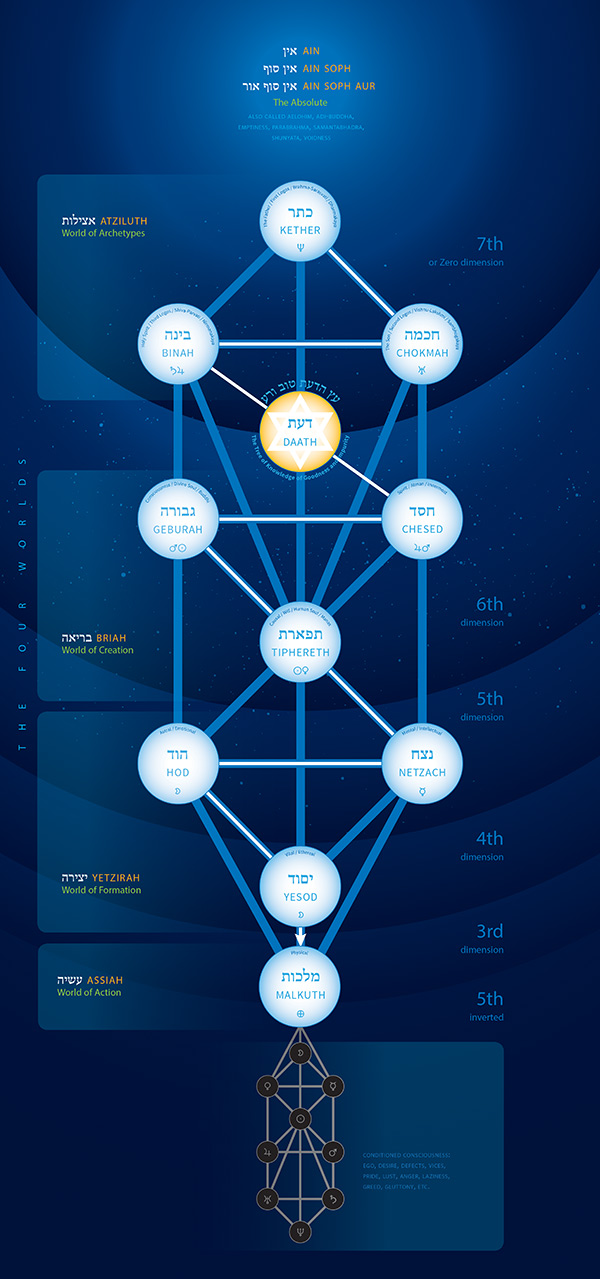
The Tree of Life (Kabbalah). Get the poster.
The physical world in Hebrew is called Malkuth, which means the kingdom. It is the lowest sphere. That is where we live. All of these other worlds above are more subtle levels that are interpenetrating this one. They are not above our heads, they are not off in space somewhere. They are here, right now, but are more subtle than the physical realm. They are all populated. All of them are populated with beings, who vibrate at those levels in nature.
At the same time, there are more dense levels of life. We call them the hell realms. They are right here, right now, and we experience them according to the state of our mind. Most of humanity is already in hell psychologically.
Our physical body is just a vessel for our psychological experience, and our physiological experience is mapped here on this graphic. Our psychological experience changes according to the condition of our psyche.
Some of us live lives that are truly hell. How many people on this planet are in constant suffering, afflicted with constant anger and lust, addiction, craving, insatiable desire and envy, and fear? Consider the widespread psychological suffering, not just physical suffering. That is hell, which we are experiencing through our physical bodies. That hell level is represented in this lower shadow of the Tree, which is called Klipoth, which in Hebrew means “empty shells.” That is not in some other place, that is here. It is a reflection of our psyche.
Someone who has no conscience is an “empty shell.” The conscience is that last remaining fraction of Consciousness that is unconditioned, unmodified, and capable of recognizing good from bad. An “empty shell” has no conscience, no humanity, only defects, vices, desires, cruelty, etc. We see plenty of those types of people all over the world. Just watch the daily news. You can easily find people that have no conscience. They are willing — easily — to kill, to rape, to steal, to maim, to lie. They are empty shells. They have a physical body, but psychologically they are demons. They are not human, because they have no conscience. So, demons are not fantastical beings: they look like us, eat like us, talk like us, but they have no conscience. You cannot tell who is a demon by their appearance or their manners. In fact, demons love to appear sweet, kind, intelligent, beautiful. They do not know they are demons. They believe they are good. Yet, they are everywhere among us, awaiting the moment to do evil, and enjoy doing it.
Similarly, there are beings with very high, very pure qualities, who walk among us, yet we cannot perceive they have those qualities, because of the conditioning of our Consciousness. We, who are so afflicted with desire and trauma, only see the world through our conditioning.
All these beings, angels and demons, masters and devils, whatever we want to call them, they all have Consciousness at their level. They may or may not have physical bodies. But they all share Consciousness. This is universal amongst all living things. What is important about that is that we have it too, which means that we have the potential to raise or lower our Consciousness. That is done simply by how we behave, how we act, how we use the Consciousness.
The problem is that we generally are not aware of how we use it. We generally are just on autopilot, going automatically through the motions of our life, chasing our desires, living from day to day until we finally die. We do not utilize these powers of our Consciousness. We are not aware of our state of Being. We are not aware of perception. We are not aware of having an alert cognitive state. We just go along from moment to moment, day to day, doing what we feel we need to do or want to do without ever being aware of it, without being aware of how we are using that energy. This is precisely why we are in the problems that we are in. To change that we need to learn about the Consciousness, what it can do. It has some basic powers. And this is universal to all living things.
These are very technical terms, we do not use them lightly or loosely, so it is important to know exactly what they mean.
Basic Powers of the Consciousness
- Awareness: Broad spatial perception
- Attention: Focused specific perception
- Mindfulness: Recognized continuity
- Visualization: Non-physical imagery
1. Awareness
The first power of the Consciousness is simply awareness, the doorway to the most kindergarten level of spirituality.
Awareness is simply perception that is very broad, wide, that expands out around you. Awareness is like sunlight: it spreads out everywhere. When you arrive to a new place, you can be aware of everything around you through sight, smell, touch, hearing.
All living things have awareness to some degree.
2. Attention
Attention is directed and specific. It is focused on one thing.
Awareness and attention are complementary, but different. Awareness is like a radiant light that sheds light in every direction. Attention is like a spotlight or laser shining on one thing. Both function at the same time and even independent of each other. This is really important to understand how Meditation works. You need to understand the difference between them and how to use them.
For example, you can be aware of this room, you can be aware of the chair you’re in, you can be aware of the temperature, you can be aware of how you’re feeling in general, but your attention is on listening to what I am explaining. This is the difference. It is simple, but needs to be clearly understood.
3. Mindfulness
Mindfulness is another word being tossed around a lot in a very vague way, and people are confused about what it really means.
Mindfulness is to have cognizance of the continuity of the Consciousness. Mindfulness is to be aware of what you’re doing from moment to moment.
When you are mindful of what you’re doing, you are fully conscious of your actions. Unfortunately, we have not learned how to use this skill the way we should.
When you sit down to watch TV, you may be aware of entering the room, you sit on the couch, you turn the television on, and you may be aware of doing these things. Your attention goes to the TV. But then you get sucked into the story or to whatever is happening on the television, and you lose awareness of the room, and you lose awareness of the television, and you become “in” the show. You forget yourself. Isn’t this universal experience? And we want that “immersion,” right? We want to forget our problems and forget ourselves. But actually, that is a negative state of Consciousness. Because, no longer aware of yourself, you enter into a state of hypnosis, a state of sleep, a dream state. Hypnotized by the story, by the emotions, by the drama, you forget reality. You become absorbed in an illusion, and you forget reality. Most of us think there is nothing wrong with that. But actually, it creates a lot of problems for us.
4. Visualization
The fourth power of Consciousness is visualization. This is the ability to perceive non-physical imagery. This is a very important power of the Consciousness that in these days many Meditation groups completely discard, and actually tell you to avoid.
The perception of non-psychical imagery is a basic power of the Consciousness. It is natural, it is normal and it is necessary. In fact, spiritual development is impossible without it.
We will talk more about these four powers throughout the lectures. We are just introducing the subject.
Awakening the Potential of the Consciousness
The key thing to understand is this:
“…Consciousness has the potential to increase to an infinite degree.” —the 14th Dalai Lama
That is what the Tree of Life represents: the infinite potential of the Consciousness. The infinite potential of the Consciousness depends on its condition. To have the potential to do something is not the same as to do it. To believe in it is meaningless.
In modern society everyone talks about having dreams about the future, and we encourage our children to have dreams, to pursue their dreams. What we do not realize is that dreams are illusions. As long as we leave them as mere dreams, they are nothing. Really, they are nothing. If we have the dream of becoming a Buddha or a master, an angel, if we have a dream of going to heaven, it may be beautiful, but it is meaningless.
The actual experience of spiritual development is completely different from our “dreams” about it. If today, in facts and measurable events, we are not experiencing the progress of the soul towards the superior realms, then we are not accessing it, and we will not if we continue behaving as we are now.
Spiritual advancement cannot be had by dreaming about it. Forget dreams. Toss out beliefs and theories.
The development of the Consciousness does not occur in the future. It occurs here and now, in the moment.
Consciousness is about the present moment. The future does not exist. Neither does the past. But you see how much of our time and energy is spent projecting about the images of the past and dreaming about the images of the future, and very rarely actively perceiving the present moment. This means we live our lives in a dream state: dreaming about the past, dreaming about the future, dreaming about what we want and do not want. Meanwhile, doing nothing, just existing. This is really sad. But these are the facts of the state of humanity. We are talking about facts here. Everybody dreams about going to heaven. But who is making the changes in the conditioning of the Consciousness to achieve create it in the here and now?
Spiritual development is a measurable result. It is not a future result. You cannot measure the future, because it does not exist.
Spiritual development is measurable in observable facts. What are the facts of your spiritual level, right now?
In Tibetan Buddhism it is said that if you want to know what will happen to you when you die, look at what happens to you when you fall asleep tonight, because the realm that you enter when you die is the exact same realm you enter when you dream. So if tonight when you go to sleep you have no awareness of falling asleep and going into that world, and no awareness of what happens to you when you’re there, then the same thing will happen to you when you die. You will have no awareness of it. Then, when you’re reborn it is like waking up in the morning: you will become aware of being in a body, and wondering where you are.
We can develop the ability to let the physical body fall asleep, which is the sephirah Malkuth, and for the Consciousness to go out of the body to dream into the fifth dimension, which is at the level of the sephiroth Hod and Netzach on the Tree of Life. We can do this with awareness, with Consciousness, and confirm it is real. Some people call this lucid dreaming, dream Yoga, astral projection, there are many names for it.
We all go to that world every single time we fall asleep physically. The Consciousness goes out of the body and wanders around, but does not realize it is there, because we are dreaming in the same way that it dreams when it is in the physical body. But if you start awakening in your physical life, being aware of yourself from moment to moment all the time, you will start to do that in your life outside of your body every night. You will start to remember more dreams. You will start to be aware in your dreams. You will start to confirm the reality that you’re not your physical body.
You are the Consciousness. You go out of your body every night. There is a whole other life there that is actually more real than this life in a physical world. It is more real, more vibrant, and more alive.
What we are explaining here is that there are degrees of Consciousness. The Dalai Lama said there are infinite degrees. It is hard to talk about infinity, so we will narrow the range a little bit, so that we can understand what that means.
Awake or Asleep?
Most importantly, we need to understand the difference between being awake and asleep.
Spiritual people always toss around this notion of “being awake.” Someone is “awakened,” they say, but very few people know what that means.
To be “awakened” is not something extraordinary or supernatural. Firstly, it is simply to be here and now, and aware of it. It is to have the Consciousness fully engaged in the present moment to the fullest capacity that you have. To really use it.
Remember those four powers of the Consciousness?
Awareness, spatial sense, which is broad, expansive.
Attention, which is directed, focused.
Mindfulness, which is to be aware of the continuity of those perceptions.
Together, they form the experience of being here and now, aware of where you are in your body, actively watching your body. Feeling it. Perceiving through all it senses. Engaged in the moment. Actually be aware of what you are doing. Attention is that part of Consciousness that’s really looking at what you are doing. So I am aware of walking around, but I am paying attention to what I am saying. But then there’s also the mindfulness, which is the being aware of the continuity of that, from moment to moment, and not losing that continuity.
Some of us can pay attention and be aware for a second, five seconds, ten seconds. But then they get distracted by thoughts or feelings, or memories, worries, concerns. And we fall asleep again. This is the distinction: awake versus asleep. To be awake is to be here and now. Present. But our capacity to be awake is completely different from the capacity that a master has.
Someone like Jesus for example, is extremely awake. So are people like Buddha, Krishna, Moses. There are many examples of great masters who have great awakening, meaning that they have a power of Consciousness that is like our little candle flame compared to a Sun. For us it is unimaginable how much power flows through their Consciousness, their ability to perceive. So they see not just where they are physically, the way we do.
As you see, our Consciousness can barely perceive the physical body. We are making effort to be present, to be in the moment, and we are trying to observe things. But it takes effort for us. It takes energy. And its range is very limited. We are not really aware of much, even when we are making a lot of effort. And we cannot pay attention to much, even when we make a lot of effort. And worse, we cannot maintain the continuity, the mindfulness of what we are doing from moment to moment. So maybe here and now in class studying we can be aware of ourselves for brief periods as I give a lecture, but probably you will find in a moment you will get distracted again and lose track of what I am talking about. When you become aware of yourself again you think, “Oh, wait, what is he talking about now?” And five minutes passed, or ten minutes passed, and you are not exactly sure how long you were distracted — in other words, you were not even here. You “went somewhere else.” So, for us there are periods of being aware and periods of being asleep. This shows in facts that our mindfulness is not strong.
Moreover, the range of our perception is limited. We barely perceive the physical body, and through the physical senses, much less anything in other dimensions. A master can perceive multiple dimensions, not just physically. It doesn’t matter if we believe that or not. It can be done. If we work on awakening here and how, we can confirm it.
So, the Consciousness can be awake or asleep, active or passive.
Those are general states, and each one has many levels. It is like light: a light can be on or off. Yet, as you know, light can be very dim or blindingly bright. Similarly, darkness can be mild or breathtakingly black. The state of our Consciousness is the same.
Conditioned or Unconditioned?
Whether active or passive, the Consciousness is also conditioned or unconditioned. As with light, a light can be pure or filtered, colored.
When the Consciousness is conditioned, it means that our perceptions are filtered. That means we do not see reality.
If you wear colored glasses, everything you see is filtered by that color. You do not see what is actually there. This is what is happening to us psychologically: our perceptions are filtered by many conditions.
On the most fundamental level, our Consciousness is filtered by being in a physical body. We are perceiving through the senses of the body, and those senses have a limited range. The eyes can only see the light that the physical eyes can see. We know scientifically that there is much more light than visible light; in fact, visible light is only a fraction of the light that is surrounding us all the time. But, our physical eyes cannot see more than that. The same is true of our hearing, our sense of touch, sense of smell. Even our dogs can smell more than we do. There is a lot going on around us on every level that we have no idea about. We think we see everything and know everything — we really believe we are so incredible — but we barely perceive anything at all, even just physically. We see a very narrow range. That is simply a matter of the conditioning of the physical level, but that is not the most fundamental or the most important conditioning that we suffer.
Our mind, our psyche, our perception, is conditioned by our past experiences, by our traumas, by our desires, our fears, our resentments, our anxieties, all our stress. All of that collected baggage, which are the results of our previous actions. Our perceptions are filtered by all of that, and we do not have any awareness of that fact.
When we see other people, we are always translating our perceptions according to our conditioning. When we see anything outside of us, we interpret those perceptions according to our conditioning, all without awareness of it.
For example, if we go outside and encounter a dog, every one of us will react differently to the same dog because of the experiences we had in the past. We will not perceive the facts of the dog as it is; instead, we only experience the psychological reactions that arise within us. I know someone who as a child was bit by a dog. She is now terrified of dogs. I know someone else who loves dogs, grew up with dogs, had lots of dogs as pets. She was also bit, but it was not traumatic for her. These two people had totally different experiences, different backgrounds, different conditioning, different reactions, different responses. One sees a dog now and suffers emotionally. One sees a dog now and is happy emotionally. Both responses are because of their unique conditioning. Neither one sees the dog for what it is; instead, both see the dog through the conditioning of the psyche. They are not seeing the reality of the dog, the facts of the dog. They do not see the soul of the dog. They see their memories of dogs, their emotional response to the dog. There is a big difference.
We do that with our perceptions of absolutely everything.
We do not see other people for what they truly are; we only see the perceptions filtered through our conditioning.
We do that with ourselves. None of us see ourselves the way we really are. We see ourselves through our conditioning.
No one on Earth sees you the way you see yourself.
So, what is the reality? None of us know. Our perception of the outside world and the inside world is completely filtered, flawed, inaccurate, and we do not have any awareness of that because we are so conditioned.
Why is this important? Because we suffer. We are suffering. Every being is suffering because of this. Because we do not see reality.
As much as we try to change the external conditions of our lives, they never change the fundamental cause of our problems, which is our psychological conditioning.
We believe that buying new things will make us happy, or moving to a new city, getting a new car or new boyfriend or girlfriend, or going here or going there. These actions never bring us the happiness we sought. Yet, we keep trying, believing in our “dreams,” chasing after illusions and passing day to day in a dream state, never realizing that the problem is not the external circumstances, it is our internal conditioning. We do not realize that we are not in a perfect state of Consciousness. We are in a conditioned state.
Unconditioned Consciousness: Nous
In Greek, the state of perfect Consciousness is called Nous. This word has a lot of depth and subtlety.
A perfect state of Consciousness is one that is completely unconditioned. To use a popular term or phrase, we can say liberated or self-realized. Nous describes a Consciousness that knows itself completely, is fully cognizant of its reality, its true nature, is absolutely free of all conditioning, and is completely happy. It is a radiant, brilliant, beautiful, wisdom-love. It is a reflection of all that is the most divine. It sees reality. It sees not only the physical appearance of any given thing, it also sees it in the fourth, fifth, sixth, and seventh dimensions at the same time. It sees the apparent reality and the ultimate reality, simultaneously, effortlessly.
This state of Consciousness is that of great masters like Jesus, Buddha, Moses, Krishna, Padmasambhava, Milarepa, etc.
Unconditioned Consciousness is represented by a light at the top of the Tree of Life called the Ain Soph Aur in Hebrew . That means “limitless light,” which in Sanskrit is Amitabha. It is the light of all the Buddhas, the ultimate light of divinity that projects out and gives life to all things. We have that potential in us. Every living thing can become an embodiment of that light.
The perfection of that in Sanskrit is called Paramarthasatya, which is an embodiment of absolute knowledge, absolute happiness, cognizance. It is a perfect being. There are many such beings. We can barely understand them, because we are so far from that state. But to know that it is possible and that it exists, and that we can become that, is very important. It gives us hope.
Conscious Revolution: Dianoia
We need to be in the state of being that is working towards that goal. In Greek, it is called Dianoia. This also is a very subtle word with a lot of deep meanings. We call it “the third state of Consciousness.” It is the state of Consciousness of someone who is constantly from moment to moment working to be conscious of themselves using every ounce of their power: physically, emotionally, mentally, spiritually. They are working to change, to liberate themselves from their conditioning, to eliminate from themselves all their anger, pride, lust, fear, greed, envy, gluttony, laziness. All of it. In other words: they are giving up the selfish “I” and seeking only to serve the greater good. They aspire to become liberated from all that conditioning and to become a real human being, an embodiment of love, diligence, generosity, heroic action for others, and all the other perfections of the soul. In other words, this is a person who is regenerating themselves, seeking to kill all the impurities inside and give birth to all of purity of the divinity. That is a beautiful goal. It is very difficult to achieve, but it can be done.
Importantly, someone who is working in this level is not just thinking about it or reading about it: they are awakening. They are experiencing it. Their Consciousness is being liberated, and it is expanding. They are perceiving more, seeing more, experiencing more. This includes awakening in other dimensions.
Dreaming Humanity: Pistis
Then we have Pistis, a Greek term also with a lot of subtlety and depth. Here we use it to refer to the level of Consciousness of the common people, all the people in the world who think that they are awake and good, and think they are going to heaven or nirvana, but are in fact deeply asleep. They exist in a dream state, filled with vices, defects, and perversities, but convinced they are awake and aware.
Pistis refers to the level of Consciousness of a common person who is completely asleep, wants to do good, but always helps themselves first. Each person wants to be loving, but inevitably has anger, hate, resentment, jealousy, and cannot seem to change it. That is the level of Consciousness called Pistis: the average person, asleep and dreaming that they are awake.
Brutal, Selfish Humanity: Eikasia
Then there is the level of Consciousness of degenerated people: Eikasia.
Eikasia refers to the level of Consciousness of people who are basically animals in humanoid bodies. Such people are bestial, instinctive, ruled by desire, anger, pride, lust. They have no interest in anything but satisfying their desires, and they do not care what it costs them, or how much they make others suffer. In these moments, there are a lot of people like that in the world. These are people that take whatever they can from whoever they can anytime they can, and they do not care about the consequences. They do not care about anything but feeding their desires, no matter the cost.
In this level we can include those who are awakening negatively, those who awaken the Consciousness while it is still conditioned by pride, lust, anger, envy, etc. In other words, they are demons, dark witches, and dark sorcerers. They look like regular people, but their Consciousness is awakened within the conditioning of their defects and impurities. They are very dangerous, and create a lot of suffering for themselves and others.
What is Our Level?
We have the potential to have our Consciousness at any of these levels, but it has nothing to do with beliefs. It has to do with our state of being from moment to moment. How do we behave? How do we act? How do we use our energy?
What we believe, what we think, what we dream, mean nothing. We are proven through our actions, through facts.
The images of the Tree of Life and the Bhavachakra represent levels and levels of Consciousness. Those levels are experiences of living that are determined by conditioning of our soul, our Consciousness.
The Tree of Life is the basis of all the Western traditions, even if they have forgotten about it. All of these terms written on the Tree of Life are hidden throughout the Bible in Hebrew ; if you do not know the meanings of the Hebrew letters and words in the Bible, then you can never understand what is written in the Bible.
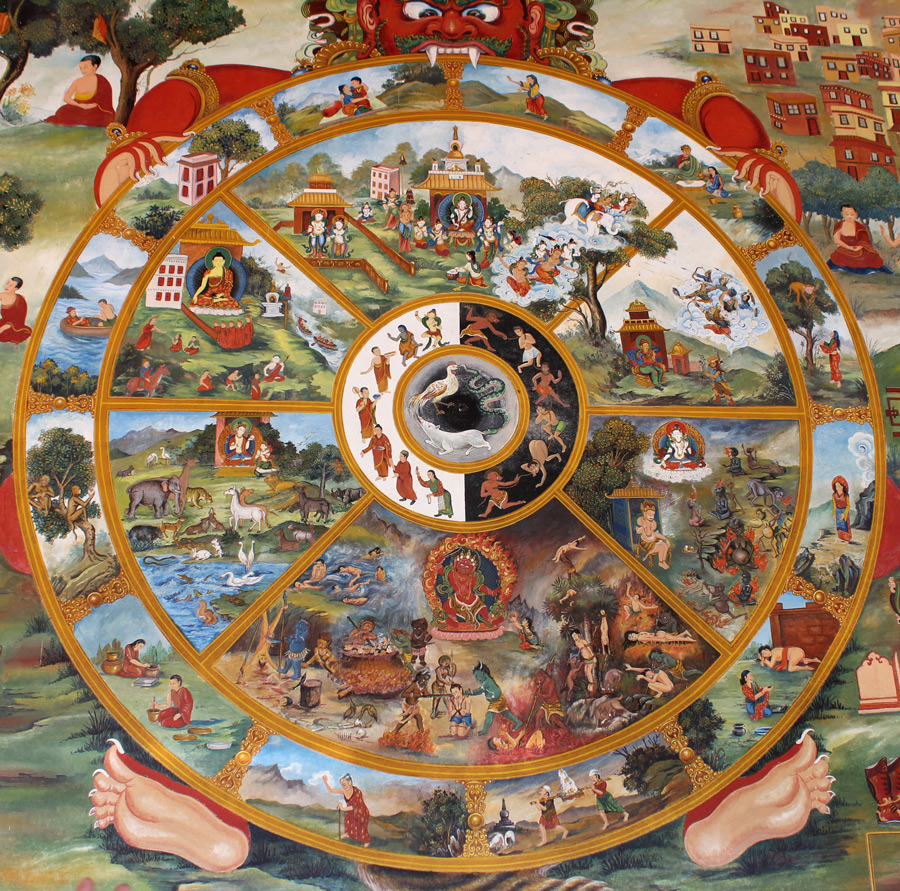
The Bhavachakra is a fundamental symbol of the Eastern traditions. It represents not only the six kingdoms of different beings, but Pratityasamutpada, which is on the outer ring as the chain of causality of all things. The center ring represents the transmigration of the Consciousness through levels of existence. The very heart shows the three causes of suffering: ignorance, craving, and aversion.
Both of these maps talk about exact same thing from a slightly different angle. Both of them are maps of your soul. They also reflect the exterior world, all the beings that migrate through nature: angels, demons, spirits, gods, demigods. All of that is represented here. But that does not mean anything to us. What should mean something to us is who we are, where are we going, how we can change for the better. These maps reflect that. They can teach us that. Most significantly, they represent the potential to change.
Nothing remains the same. Everything depends on cause and effect. If you want to rise up to a higher level of being, you only need to act in the way that creates that result.
The Wheel of Becoming
People call this symbol the Wheel of Samsara or the Wheel of Life, but the actual name is Bhavachakra, which means the Wheel of Becoming. That wheel is the motion of our own actions from moment to moment. That motion is what determines what we will become. It also means that what we are now was made by what we did before. Our parents did not make us this way. Neither did our boss or our husband, or wife, or girlfriend, or boyfriend, or friends, or siblings. It wasn’t our country or our city. It wasn’t our education. We made ourselves as we are through our choices. And not just what college we chose to go to or what types of clothes we decided to wear. Our choices from moment to moment. How we respond to life is what determines who we are.
The wheel shows six general kingdoms of experience.
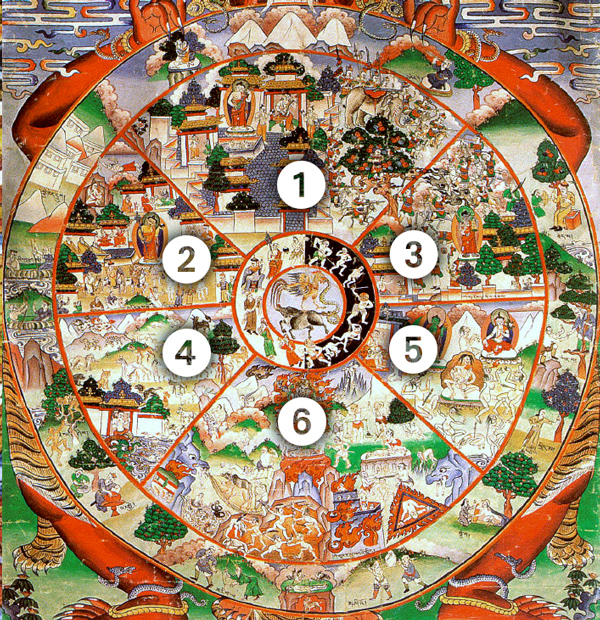
At the top are “gods,” those beings who seem to have everything: power, food, water, fine clothes. They have everything they could possibly want, but they are not happy, because they still want more, and meanwhile others are trying to take it from them. As much as they eat and drink, they are never satisfied. With all the fine clothes they get, they are never satisfied. They need more and more. Moreover, at any instant they could lose it all. Most people who study Buddhism think these “gods” are like Zeus, Krishna, or other gods from different pantheons, and it can mean that, but more importantly it also represents the wealthy people on this planet. Compared to the rest of us, the wealthiest people do live like “gods,” and everyone else worships them and wants to take what they have.
Truthfully speaking, if we look at humanity as a whole and the observation of the facts, most people in places like the United States and Europe could be considered “gods,” because even though they may not be super-wealthy, they do have access to all the best food from the planet, the best water, the fine goods, etc — Americans and Europeans can get whatever they want, whenever they want it, yet they are never happy; instead, they are always seeking more, more, more, and never find contentment in external things.
There is a statistic that says that if your family earns more than $50,000 a year, you are in the top five percent richest of the worlds population. None of the Westerners realize that. Each person thinks they are too poor and do not have enough; even the very rich feel that way.
Each of the other kingdoms also represent people around us right now:
- the demigods are those who have more power and wealth than others, yet are driven to become gods, to have even more; they are proud, boastful, often beautiful in appearance, but are driven by greed and competition
- the human beings are those who are average, in the middle, neither in hell nor in heaven; surviving, but also victims of circumstances, asleep, dreaming of becoming gods or demigods, while being afraid of falling into the lower realms. for most of them, they are born, grow up, give birth, raise kids, get sick, and die, without ever knowing why
- the hungry spirits are those who from day to day are starving, addicted, burdened by poverty and self-destructive habits. even when they get what they want, it hurts them, and makes them suffer more. these include alcoholics, sex addicts, drug addicts, gamblers, those addicted to money, properties, possessions, etc.
- the animals are those who live entirely driven by instincts: fear, lust, hunger, the desire to dominate others. this includes those who are fascinated by their own body or the bodies of others, who live only to eat, have sex, and sleep
- the hell realms are for those who suffer the most: those who live in slavery, in war zones, under dictatorships or tyrants, who are completely trapped an have no means of escape from suffering except death. In these times, their numbers are uncountable.
Without exception, all of these beings migrate from kingdom to kingdom based on their actions.
The wheel spins around an axis: in the center of the wheel are the factors around which all conditioned existence spins: craving, aversion, and ignorance of reality.
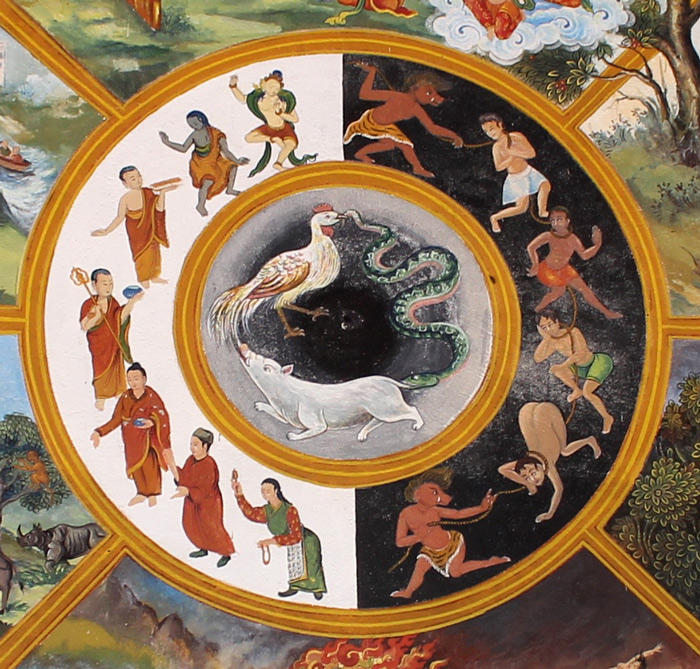
Those describe our conditioned state: we are always craving desires, we are always avoiding our fears, and we are in complete ignorance about reality.
You see, the Bhavachakra maps our mind.
The Reality of Suffering
What keeps this cycle moving is the ignorance of who we really are. We think we are this person with this name and this body, and our specific “look,” and “style,” and our taste in music and clothes, and politics. It’s all lies. It’s all random stuff that we’ve just picked up along the way that truly means nothing. We do not know who we are as a soul. We do not know our level of being. We do not know what will happen when we die. We do not even realize that we are going to die. We do not know where we were before we were born in this body, and we do not know where we will go when this body dies. Moreover, we do not realize that everything we accumulate in this life will be lost. Yet, we relentlessly pursue acquiring more! Why? We are going to lose it all. Why go to so much trouble? We do not have any awareness of any of this.
So you see, no matter what kingdom we belong to on that wheel, we are suffering. All the beings in all the kingdoms on that wheel suffer: the gods, the demigods, the human beings, the animals, the hungry spirits, and the demons. All suffer according to their conditioning. None have contentment, peace, knowledge.
We tend to think of suffering as just physical pain, but that is not the entirety of suffering. That is not the real meaning of the word suffering. That is just the first type, the obvious suffering: the suffering of suffering, which includes pain, birth, illness, growing old and dying. These are obvious, and everyone of us has to face them. They are unavoidable, yet we believe we can avoid them. We have so much aversion to them, and we suffer because of that aversion. We do our best to avoid the reality of growing old. We get surgeries to look younger. We have all kinds of make-up to hide our age, we try all kinds of things to avoid the fact of aging and avoid the fact of the inevitability of death. We do not want to face it. And we suffer because of that.
If we really face the reality and understood it, we would not suffer, especially if we are preparing every day for death. You see that phrase I told you earlier: if you want to know what happens when you die, look at what happens when you fall asleep at night. That is not just to scare you. That phrase is given so that you will realize “if I can understand what happens when I die, I can be prepared to die and not be afraid.” You see, personally I am not afraid to die. I am afraid of pain. I am not over that yet. But I am not afraid to die, because I know what will happen. You too can train yourself every day to comprehend and understand what the process of death is so that you are not afraid of it. Thus, you will suffer less. And then you can help others to not suffer. What better the use of your life than to reduce your suffering and the suffering of others?
Deeper is the suffering of change.
We all have this anxiety or stress of trying to hold on the things that are constantly changing. We are trapped in this illusion. All of us want to retain our youth. You see how people are desperate to retain youth? They want to look young. I see old people that are dressing like teenagers and they get all these surgeries to try to look like young people, because they are trapped in this illusion. They are suffering the suffering of change. They cannot accept the reality of getting old.
Why do people ignore the elderly? Because when we see older people, we have to face the fact that we too will get old. And sadly, people do not want to accept that reality. So, the older people suffer being forgotten, isolated, ignored, etc.
And what else? We cannot accept the reality that our children will grow up and leave. That our children will get sick. That our children will die.
We cannot accept the reality that the vast majority of external circumstances are completely of our control.
We are always thinking, trying to figure out “how can I control my life? How can I control what’s going on, so that I can have security and comfort?” You never will be able to do it. You will waste your whole life chasing that illusion. The vast majority of people on this planet suffer from that anxiety or stress of always trying to manipulate and change and hold things that cannot be held. This is a very deep suffering. If you really contemplate this, you will see it is at the root of the majority of the problems we face as a planet.
We want this idealistic belief of being what we see in ads: those young people in the ads that are so pretty and so handsome with all the fancy clothes, the nice car, the nice house, smart kids that are on their way to being doctors. This perfect life that our media has held up in front of us as a carrot to make themselves rich. And we all pursue that blindly, not realizing it’s 100% a lie.
Life does not work like what we are shown on tv. But we are so conditioned by the media programming that we do not realize it.
Deeper and harder to understand is the suffering of conditioned existence. It is very difficult to grasp what this is. It is subtle. It is a pervasive unsatisfactoriness. No matter what we do, what we achieve, what we gain, what we gather, we are never content.
The reason for that is we have a mistaken perception of what our “self” is. We do not see the reality. We think that if we get that job, that education, we live in that place, we get married, we get kids, we do all of the things that society tells us then we will be happy. But it is not true. Because none of those things last. They are fleeting. They are like a mirage.
All the while, we ignore that can bring contentment. And that is to know who we really are, which is mapped on this image.
That is inside of us. Not outside. What is our reality? What is our Being? Some call that God. But that term has a lot of baggage. The term Being is better, because it is an active state.
What is our true self? We do not see it. We do not know. So we suffer. And all of this is because of that.
On that wheel, the very center has three creatures and the root one is ignorance. That is the ignorance of the true nature of oneself. It is to not know the reality of oneself. It is the center of the whole wheel. It rotates around that fundamental ignorance.
This is why we meditate. This is why: to learn from experience about reality. To cut through all the illusions in our perceptions.
“We are liberated from illusions and conditioning when our delusions and contaminated karmic actions are exhausted.”
This is a quote from Nagarjuna, who is a great master of Buddhism.
Liberation from suffering is not a matter of belief. Billions of people believe billions of things and all of them continue to suffer. No matter what you believe, it does not change your suffering, the fundamental facts. Belief does not help us here.
What helps us is to deal with delusion. You see how close that word is to the word illusion? It is an image. A delusion is an image. But it is psychological. Not outside. It’s the delusions that we have in our heads. It has nothing to do with anyone else. It’s all about ourselves.
We are liberated when our delusions are exhausted, when we can see the illusions for what they are. When you see and realize that something you thought was real is not real, it loses its power. If someone comes to you and calls you a terrible word, it hurts your pride. You feel pain. If your best friend says it, your parents say it, your sibling says it, your teacher, someone you respect says it, they call you really bad names, it hurts even more. But if a child says it, it does not hurt. You look at the child and say “oh, you little brat,” and you smile. Or if a sick person, someone who’s really sick, lashes out and says something disrespectful to you, you know to not take it personally because of the state of mind they’re in. Because you understand that they are suffering. You see, in each case the word is the same but you receive it in a completely different way. The word is not what is different. It is the quality that you give to the word psychologically, inside of yourself. The value you give it is what makes the difference.
We can learn that same phenomena with everything we perceive. When we learn how to perceive things for what they truly are, we reduce our suffering.
When we truly realize that the big fat bank account and the big fat ring on our finger and all the things that society says we should have really do not have the meaning that we thought they had, we suffer less.
When we realize that our age is irrelevant, that our beauty is irrelevant, we suffer less.
When we realize that we really do not care what other people think about how we dress or how we talk, we suffer less.
We suffer because of the value we place on illusions.
Contaminated karmic actions: the word karma simply means “to do.” The Bible says in several places that we receive from our actions: we reap what we sow. As you do, you receive. That’s all that karma means. Cause and effect.
We are in the circumstances we are in because of our previous actions.
If we want better circumstances, we need to perform superior actions, better actions. That’s all.
When we renounce a lower desire, a lower action, in favor of the superior one, we receive superior result. It is very simple.
The difficulty is letting go of the desires, recognizing that a desire that we really want to fulfill is not as good as performing the superior type of action. So these two are compared in a union with each other, undoing the delusions and performing superior actions are what lead us to become liberated from conditions. This is how we change our level of Being. This is how we change our relationship with this wheel of becoming. How we change our relationship with the Tree of Life. We raise our level of Being.
You know the story in the Bible of Jacob, who fell asleep with his head on the stone and saw a vision of angels going up and down the ladder? That is this ladder. It goes up and down from the superior to inferior worlds. That is in us, not outside of us.
So how do we make that change? We work with facts.
How to Change
Meditation starts in this moment.
Meditation is not something that you only do once a week, once every two weeks for ten minutes. If you really want to learn to meditate, start now.
Meditation begins with learning to use Consciousness all the time, in everything you do. To be aware of oneself. To deal with facts. To set aside beliefs. Cut through illusions. Deal with reality. That’s how real Meditation is born. It is a state of Being.
Being aware of ones’ own existence, ones’ condition, ones’ sensations, ones’ mind. Not just thinking about it, but watching it, observing oneself.
Meditation starts this with this: from moment to moment being aware of oneself, paying attention to oneself. Being mindful in a continuous way from moment to moment. Perceiving actively.
Meditation is a state of Consciousness, and that state results from having the Consciousness very aware and in the present moment.
You cannot achieve that only trying to do it only for ten minutes a day or only trying to do it every couple of weeks. It has to be a continual effort. Constant.
When you get into that rhythm of always being in the present moment, always bringing your attention to the here and now, you start to train yourself and you develop skill. You get stronger.
It’s the same as when you go to the gym and you try to do exercise. If you only exercise once a month you are not going to get anywhere. Right? Everybody knows that. It is the same with a diet. If you only diet one day out of the month, you are not going to change. It has to be a lifestyle. It is the same with Meditation, yet it is more than just a lifestyle. It is a way of being. Constant.
So from that point of view, Meditation seems difficult in the beginning. That is represented on this image of the stages of meditative concentration.
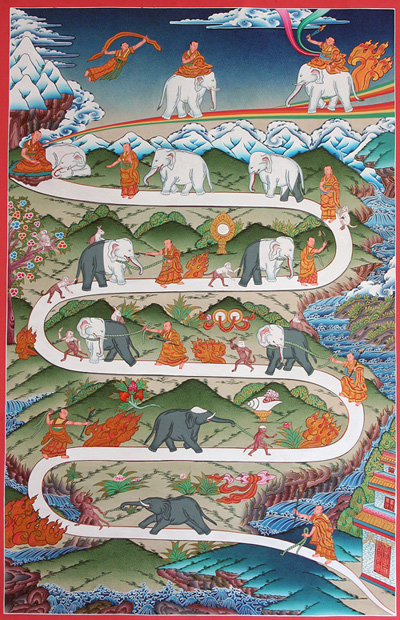
This map shows stages of the development of concentration, which is attention. As you are working to develop attention, we all start down at the beginning as the person who is practicing, chasing after the two animals: the elephant and the monkey.
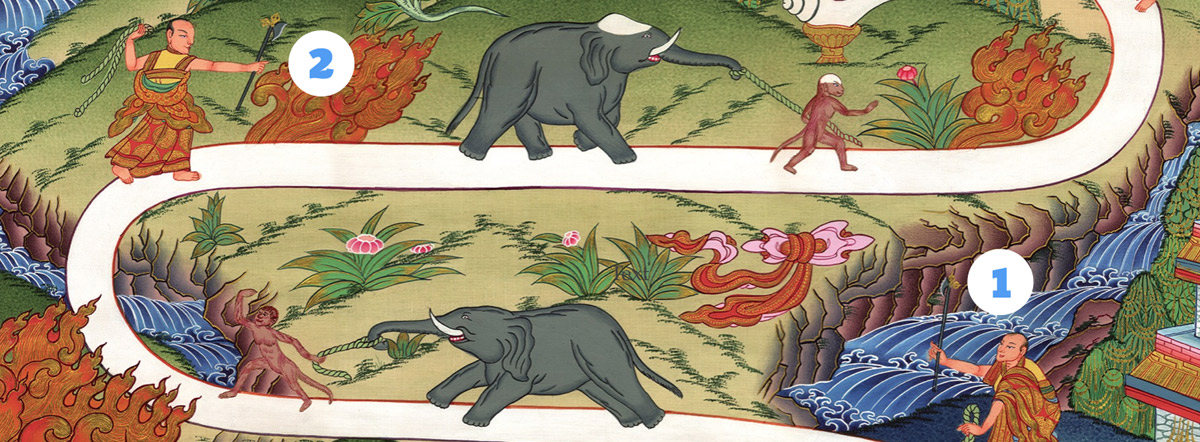
They represent the wild mind that we all have. If you have tried to meditate you realize that when you sit to meditate the mind just keeps running. It is wild. It is hard to control it. Here on the painting you see a raging fire. That represents the effort it takes in the beginning, it takes a lot of energy, a lot of effort. But as you look up this path as this monk begins to get closer to gaining control of the animals, the fire decreases. It gets smaller until it is gone. In the beginning, it takes so much effort and energy to learn this, but with experience and as your conscious muscle gets stronger, it becomes easier until it becomes effortless.
Meditation itself is effortless. The state of Meditation requires no exertion at all. It just happens. If you are exerting yourself to meditate, you are meditating in a wrong way.
This information was originally published on gnosticteachings.org. You can find more lecture transcripts by visiting them online.

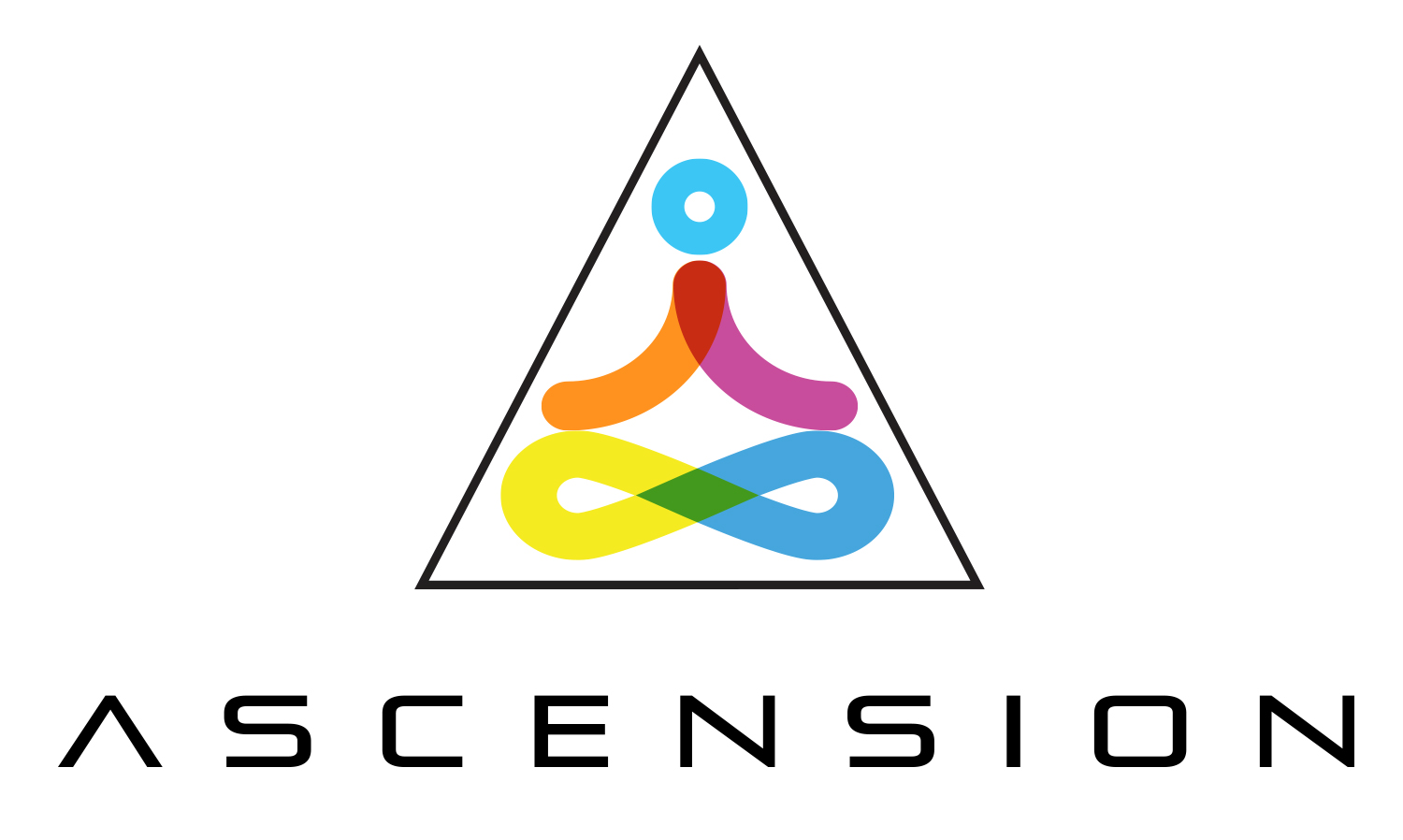
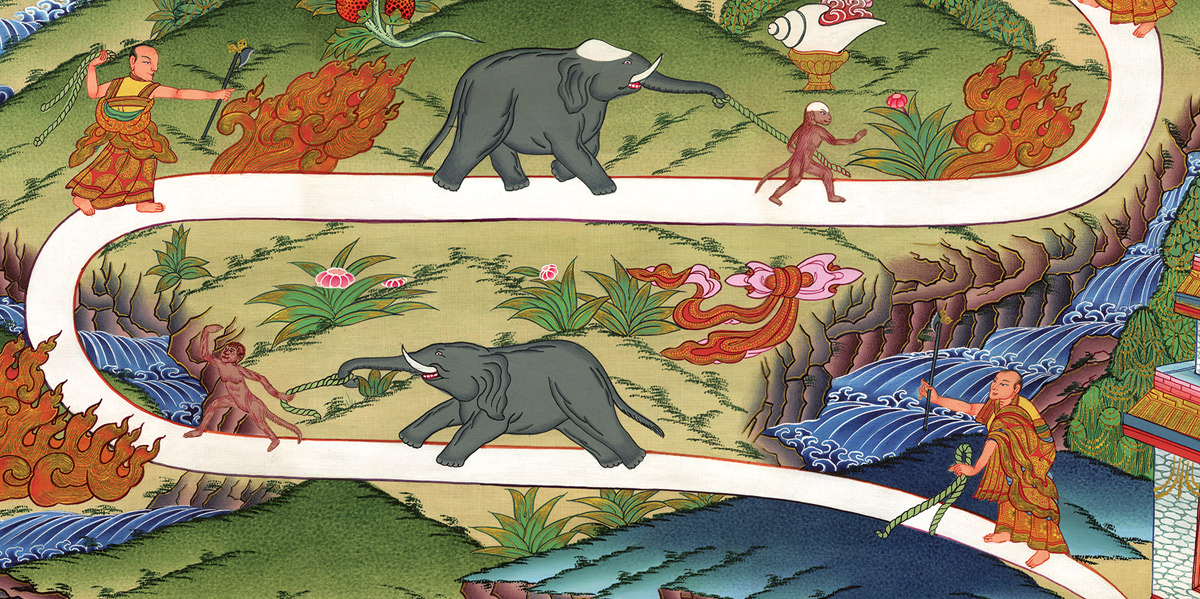
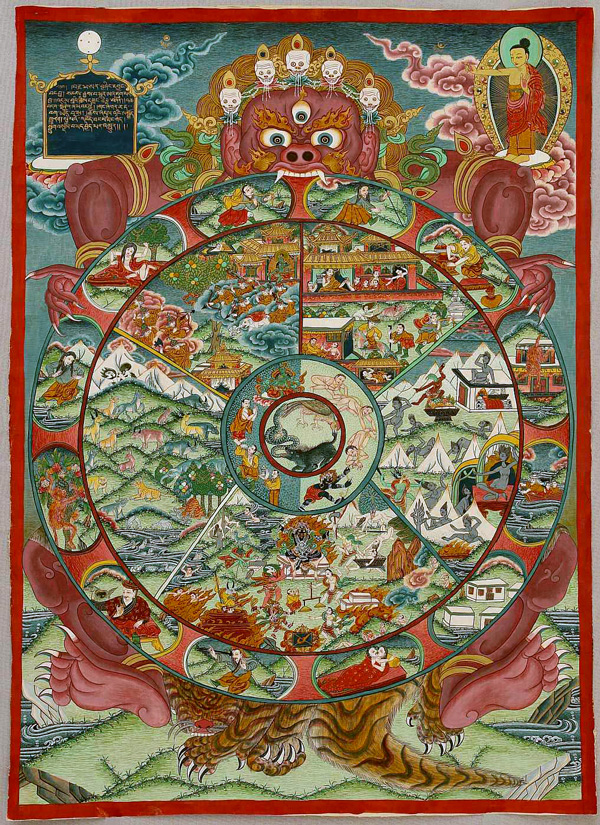
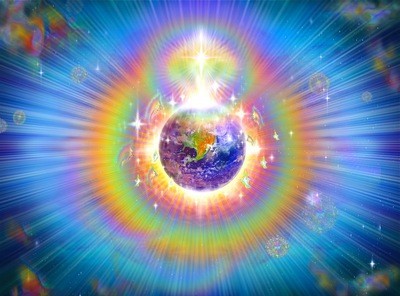
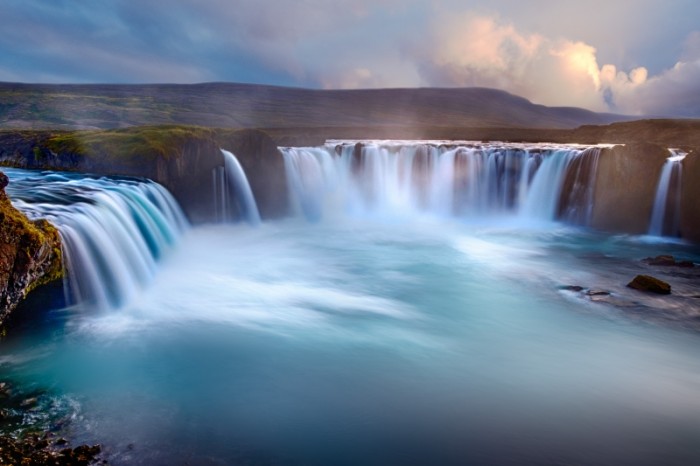

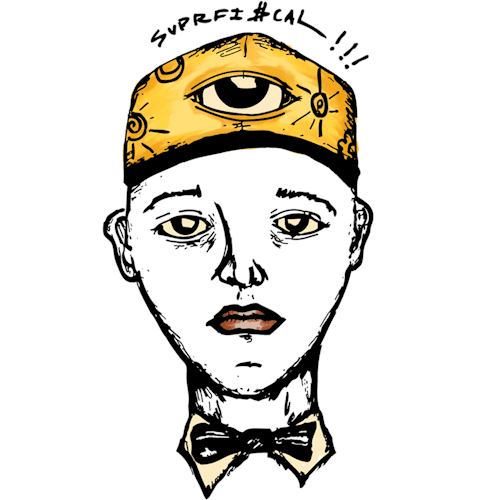
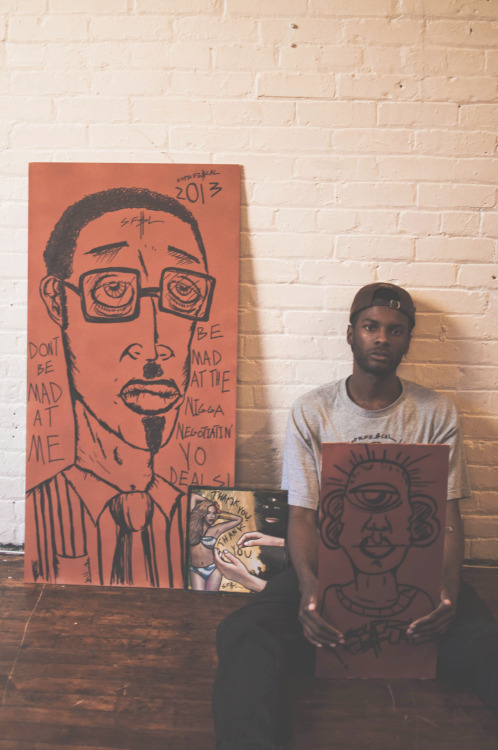 Timothy Yanick Hunter is a young Toronto artist making his mark in the art world. His collection of work primarily uses orange and red tones to seduce the viewer while questioning the role of desire in retail marketing. His art aims to explore the grey area between consumer culture and cultural appreciation. Is an artist a cultural contributor or simply a retailer of his/her works? At what point does the appreciation of artwork and people become a consumer past time? These are the questions Yanick Hunter aims to provoke and address with his artwork.
Timothy Yanick Hunter is a young Toronto artist making his mark in the art world. His collection of work primarily uses orange and red tones to seduce the viewer while questioning the role of desire in retail marketing. His art aims to explore the grey area between consumer culture and cultural appreciation. Is an artist a cultural contributor or simply a retailer of his/her works? At what point does the appreciation of artwork and people become a consumer past time? These are the questions Yanick Hunter aims to provoke and address with his artwork.